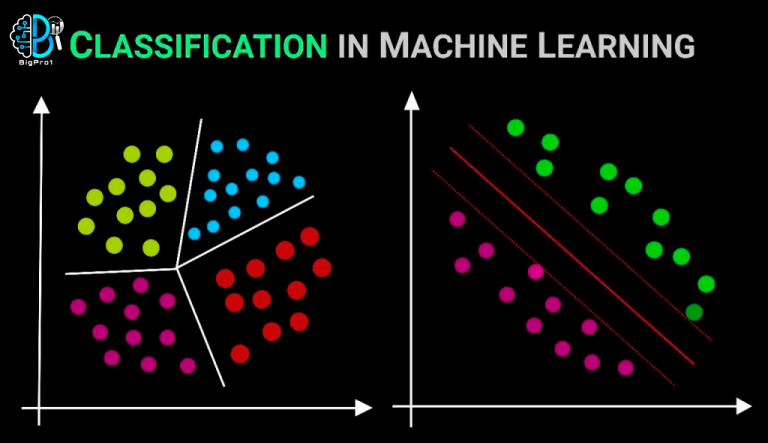A classification algorithm is a supervised learning method that aims to determine the category or label of new data based on previous data. For example, if we have animals’ data with different sizes and weights, we can use a classification algorithm to determine which category a new animal belongs to. In the following section, we will talk about classification algorithms, their types and applications, and the features of Bigpro1 in this matter.
What is classification algorithm
A classification algorithm is a machine learning technique used to classify data based on their characteristics. These algorithms use a set of training data to learn relationships between features and classes, and can then use these relationships to classify new data.
For example, suppose we have a dataset of images of cats and dogs. We can use a classification algorithm to learn which features are important to distinguish between cats and dogs. Then we can use this classification algorithm to classify new images.
The importance of classification algorithm and the reason of using them
There are many reasons to use classification algorithms. For example:
Data classification:
Classification algorithms can help organize data and identify patterns in data. This can help facilitate data access and use.
Decision-making based on data:
Classification algorithms can help make decisions based on data. These algorithms can help to make more accurate and better decisions by considering all relevant factors.
Automation:
Classification algorithms can help automate the data classification process. This can help save time and resources.
Classification algorithms are powerful tools that can be used to solve a wide variety of problems. These algorithms are very important in the modern world and are used in a wide range of fields.

Metrics of classification algorithms
Classification algorithms can be categorized based on several criteria, including:
Class type:
Classification algorithms can be classified based on the number of desired classes. Binary classification algorithms recognize only two classes, while multi-class classification algorithms can recognize more than two classes.
Statistical model:
Classification algorithms can be classified based on their statistical model. Probabilistic algorithms use probabilities to classify data, while deterministic algorithms use rules.
Types of classification algorithms
Some classification algorithms are:
Decision Tree Algorithm
This algorithm divides the data into different categories based on their characteristics. A decision tree consists of a series of rules that are used to classify data.
Logistic regression algorithm
This algorithm uses a logistic function to calculate the probability that data belongs to a certain class. Logistic regression is a probabilistic model that can be used to classify data.
Support Vector Machine
This algorithm creates a boundary between the data of two classes to separate the data of each class from the data of the other class. A support vector machine is a deterministic model that can be used to classify data.
K-Nearest Neighbor Algorithm
This algorithm classifies the new data into a class to which its nearest neighbors belong. K-Nearest Neighbor is a probabilistic model that can be used to classify data.
Naive Bayes algorithm
This algorithm uses Bayes’ rule to calculate the probability that a data belongs to a certain class. Simple Bayes is a probabilistic model that can be used to classify data.

The applications of Classification
Classification algorithm has wide applications in various fields, including:
Natural language processing
Classification can be used to identify different types of text, such as news, email, or legal documents. For example, classification can be used to identify spam, or to categorize emails by subject.
Risk management
Classification can be used to identify customers at risk, or to detect fraud. For example, classification can be used to identify customers who are likely to default, or to identify suspicious transactions.
Librarianship and information
Classification can be used to organize collections of books, or to create subject indexes. For example, taxonomies can be used to organize books by subject, or to create an index of keywords in a dataset.
medicine
Classification can be used to diagnose diseases, or to identify people at risk for certain diseases. For example, classification can be used to diagnose cancer, or to identify people who are likely to develop a particular disease.
security
Classification can be used to identify security threats, or to detect cyber attacks. For example, classification can be used to identify suspicious network traffic, or to identify suspicious user behavior.
Marketing
Categorization can be used to target ads, or to personalize the user experience. For example, classification can be used to target ads based on users’ interests, or to provide users with personalized offers.
production
Sorting can be used for quality control, or to identify defective products. For example, classification can be used to identify products that do not meet quality standards, or to identify products that are likely to harm customers.
These are just a few examples of classification algorithm applications. These algorithms can be used in a wide variety of fields to identify patterns and categorize data.

Effective factors in choosing classification algorithms
Choosing the right classification algorithm depends on several factors, including:
Data type
Some algorithms are better for numeric data, while others are better for textual data. For example, the logistic regression algorithm is better for numerical data, while the simple Bayes algorithm is better for textual data.
Number of classes
Some algorithms are better for binary classification, while others are better for multi-class classification. For example, the decision tree algorithm is suitable for binary and multi-class classification, while the K-nearest neighbor algorithm is only suitable for multi-class classification.
Data complexity
Some algorithms are better for simple data, while others are better for complex data. For example, the K-nearest neighbor algorithm is better for simple data, while the support vector machine algorithm is better for complex data.
In addition, other factors can play a role in choosing the right classification algorithm, including:
Processing speed: Some algorithms are faster than others.
Accuracy: Some algorithms are more accurate than others.
Reliability: Some algorithms are more reliable than others.
For example, suppose you want to use a classification algorithm to identify spam. In this case, you should use an algorithm that is suitable for text data and has high accuracy. Here are some tips for choosing the right classification algorithm:
Use small datasets to test different classification algorithms. This will help you identify algorithms that are suitable for your dataset.
Use different accuracy metrics to evaluate algorithms. This will help you identify algorithms that are highly accurate.
Start with simple algorithms. If simple algorithms do not perform well, you can use more complex algorithms.
Finally, the best way to choose the right classification algorithm is to test different algorithms with different datasets.
The importance of classification algorithm and its tools in doing machine learning projects
Classification tools and algorithms are very important for doing machine learning projects. These tools help machine learning researchers and engineers organize data, identify patterns, and make accurate predictions. Having classification tools and algorithms for doing machine learning projects has many advantages. These tools can:
- Simplify the development process of machine learning projects.
- Help reduce the time and cost of developing machine learning projects.
- Help improve the accuracy and efficiency of machine learning projects.
As a result, having knowledge and skills in classification algorithm tools is essential for machine learning researchers and engineers. Based on this, we in the Bigpro1 system, knowing the importance of these tools and the needs of users in this field, have provided all these needs to you.




